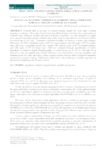Please use this identifier to cite or link to this item:
http://www.alice.cnptia.embrapa.br/alice/handle/doc/1073620Full metadata record
| DC Field | Value | Language |
|---|---|---|
| dc.contributor.author | CUNHA, J. P. A. R. da | pt_BR |
| dc.contributor.author | BARIZON, R. R. M. | pt_BR |
| dc.contributor.author | FERRACINI, V. L. | pt_BR |
| dc.contributor.author | ASSALIN, M. R. | pt_BR |
| dc.contributor.author | ANTUNIASSI, U. R. | pt_BR |
| dc.date.accessioned | 2017-08-04T11:11:11Z | pt_BR |
| dc.date.available | 2017-08-04T11:11:11Z | pt_BR |
| dc.date.created | 2017-08-04 | pt_BR |
| dc.date.issued | 2017 | pt_BR |
| dc.identifier.citation | Engenharia Agrícola, Jaboticabal, v. 37, n. 3, p. 493-501, 2017. | pt_BR |
| dc.identifier.uri | http://www.alice.cnptia.embrapa.br/alice/handle/doc/1073620 | pt_BR |
| dc.description | Abstract: Pesticide drift is an issue in modern farming, mainly for crops under constant spraying as soybeans. This study aimed at assessing drift and pest control for aerial applications in soybean crops. Hydraulic nozzles and rotary atomizers, regulated to a wide spectrum of droplet sizes, sprayed thiamethoxam plus lambda-cyhalothrin using an agricultural aircraft Ipanema 202A at volume rate of 20 L ha?1. Treatments consisted of testing two devices: a rotary cage atomizer (Micronair AU 5000) with blade angles of 65° for larger droplets, and with angle of 55° for smaller ones; and a set of adjustable nozzles (Stol model) with deflector angle of 90° for smaller droplets, and with angle of 30° for larger ones. Drift was evaluated through quantification of active ingredient, by means of liquid chromatography, on nylon strings set 20, 40, 80, 160 and 320 m downwind from the applied area. Control efficiency was measured by counting caterpillars and stinkbugs found five days after spray. Rotary atomizers produced lesser drift compared to adjustable nozzles at the designed setting. Furthermore, drift can be reduced through a suitable regulation of the devices, keeping an effective pest control. | pt_BR |
| dc.language.iso | eng | eng |
| dc.rights | openAccess | eng |
| dc.subject | Deriva | pt_BR |
| dc.title | Spray drift and pest control from aerial applications on soybeans. | pt_BR |
| dc.type | Artigo de periódico | pt_BR |
| dc.date.updated | 2018-01-24T11:11:11Z | pt_BR |
| dc.subject.thesagro | Agrotóxico | pt_BR |
| dc.subject.thesagro | Aplicação aérea | pt_BR |
| dc.subject.thesagro | Soja | pt_BR |
| dc.subject.thesagro | Praga de Planta | pt_BR |
| dc.subject.nalthesaurus | Spray drift | pt_BR |
| dc.subject.nalthesaurus | Aerial application | pt_BR |
| dc.subject.nalthesaurus | Pesticides | pt_BR |
| dc.subject.nalthesaurus | Soybeans | pt_BR |
| riaa.ainfo.id | 1073620 | pt_BR |
| riaa.ainfo.lastupdate | 2018-01-24 -02:00:00 | pt_BR |
| dc.identifier.doi | http://dx.doi.org/10.1590/1809-4430-Eng.Agric.v37n3p493-501/2017 | pt_BR |
| dc.contributor.institution | JOAO PAULO ARANTES RODRIGUES DA CUNHA, UFU; ROBSON ROLLAND MONTICELLI BARIZON, CNPMA; VERA LUCIA FERRACINI, CNPMA; MARCIA REGINA ASSALIN, CNPMA; ULISSES ROCHA ANTUNIASSI, FCA-UNESP. | pt_BR |
| Appears in Collections: | Artigo em periódico indexado (CNPMA)  | |
Files in This Item:
| File | Description | Size | Format | |
|---|---|---|---|---|
| 2017AP10.pdf | 415.93 kB | Adobe PDF |  View/Open |









